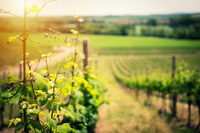 With the world becoming more aware of issues such as global warming, climate change and all round environmental chaos, we have all felt the need to become a little bit “greener” in our approach to every-day life. We buy more organic produce than ever before, use reusable bags, coffee cups, water bottles and we recycle much more than we used to. With ideas like sustainability and being more natural at the forefront of our minds, these practices are becoming the norm in the agricultural world too. You might already be familiar with organic farming practices, but for the most part - we are left wondering what producing biodynamic wine entails.
What is Biodynamic Wine?
“A spiritual-ethical-ecological approach to agriculture, gardens, food production and nutrition” - that’s the official biodynamic farming definition from the Biodynamic Farming and Gardening Association. Biodynamic wine is made with a set of farming practices that views the vineyard or farm as one solid organism. The ecosystem functions as a whole, with each section of the farm or vineyard contributing to the next - the idea is to create a self-sustaining system; with natural materials, soils and composts being used in order to help to sustain the vineyard.
Chemical fertilisers and pesticides are completely forbidden for the sake of soil fertility; a wide array of animals are used such as; ducks, horses and sheep to live on the soil to fertlise it, which creates a rich, highly fertile environment for the vines to grow in. Biodynamic farming also seeks sustainability, which relates to leaving the land in as good or better shape as they found it for future generations.
Some of these practices have been proven scientifically, like organic practices - but despite its scientific sounding name, some of the practices used in biodynamic farming methods are harder to prove scientifically. It has been found that biodynamic farming does have a positive impact on yield, biodiversity and soil quality. Biodynamic preparations have been found to express a positive environmental impact in terms of energy use and efficiency.
When Did Biodynamic Farming Start?
Well known in the world of wine, Austrian philosopher Rudolf Steiner started the idea of biodynamic agriculture back in the early 1920s - which means biodynamic practices predate the organic movement by a long while. Steiner believed that living and farming together with the Earth and its movements, rather than simply following a purely scientific approach.
How Do You Make Biodynamic Wine?
Biodynamic wine is made through farming all the components of the vineyard as one whole entity, completely removing the use of chemicals and instead using natural materials and composts. Adherence to the biodynamic calendar is another integral cog in the process - sometimes the farming practices, from harvesting to pruning are controlled by the biodynamic calendar. This calendar breaks down all the tasks associated with farming into four kinds of days; root days, fruit, flower and leaf days. Each of these days then has specific tasks associated with it, which are reflective of Earth’s four classical elements - root days are for pruning, fruit days are meant for harvesting, flower days mean that the vineyard is left alone and leaf days are for watering.
Is Biodynamic Wine the Same as Organic Wine?
In short, no. Both types of wine incorporate practices that are free from chemical intervention. However, putting in simple terms - organic wine is produced with organically grown grapes. Biodynamic wine takes into account a whole range of biodynamic farming methods which include the lunar calendar and astrology. The farming is all about the lifeblood of the vineyard, other plants, insects and animals, not just the grapes being grown.
|

